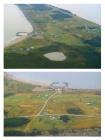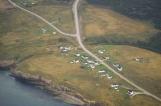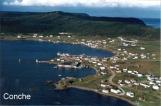2
In 1904, Petit Plaisance was re-named Argentia by Parish Priest Father John St.John after the discovery of silver deposits in the area (the future Silver Cliff Mine - "argent" being the French word for silver). The name change is also said to be a result of growing tensions between the residents of Little Placentia and Great Placentia.Then in 1941, the U.S. was given permission to build a base in Argentia. Before the base was built, the community was resettled in Freshwater. The graveyard was exhumed and the remains of those buried there were buried in Placentia. The base was one of the largest naval bases built outside the U.S. during World War II. It was the operational headquarters for ships combating enemy submarines. The base also played an important role during the Cold War.
The Argentia base was closed on October 1st, 1994, after fifty four years of service. Afterwards, all the apartment buildings, the hotel and most of the base itself was destroyed. Today, Argentia is an industrial park, site of the ferry dock between Argentia and North Sydney, N.S.
4
Battle Harbour is located between Battle Island and Great Caribou Island off the coast of southeastern Labrador. There is some uncertainty surrounding the origin of name "Battle Harbour"; it may possibly be derived from the Portugese word "batal" or boat.Battle Harbour's first permanent settlers were fishermen, carpenters, apprentices and servants. With the government-sponsored relocation of the residents and the decline of the fishery in the area, Battle Harbour was turned over to the Battle Harbour Historic Trust. Numerous historic structures, walkways and work areas have been restored or reinstated and a collection of more than 300 artifacts related to the fishery and everyday life are on display. It was designated a National Historic District on August 7th, 1999.
6
Black Duck Brook was named because of the many ducks in the area. The first people to settle permanently in Black Duck Brook arrived in the 1840's. Some of the first families to live in the area were the Benoits (1852-1856), the Bosecs (1888), the Buissons and the Felixes (1844) and the Roblets (1870). Black Duck Brook's economy was completely dependant on the lobster fishery until 1904.8
Although Blanc Sablon is located in Quebec, it was once within Newfoundland territory and is now just west of the modern Labrador border. It was originally named "Anse Sablon" which means "Sandy Cove". Over time, due to mispronunciation and corruption of the name, it has changed to Blanc Sablon, which means "White Sand". Blanc Sablon did not become a permanent settlement until the 19th Century. It was the principal fishing station on the Labrador Coast with over 300 people residing during the fishing season.10
Bonne Bay is a small bay located about halfway up the west coast of the island. It is a scenic spot with high mountains and a great view of the tablelands (a mountainous plateau thrust up from the earth's mantle during the collision of the American and European tectonic plates 300 million years ago).Bonne Bay appears on maps dating back to the late 17th century as Belle Bay, the French word for good or beautiful. Due to the bay's deep, relatively ice-free waters, the area was frequented by French ships who fished the waters at the mouth of the bay.
According to records, English settlement did not appear until the early 19th century. However, the population remained small until the late 19th century when the population started to rise dramatically. This was due to two events: the French followed the lobster fishery north and the herring fishery which was plentiful in and around Bonne Bay.






